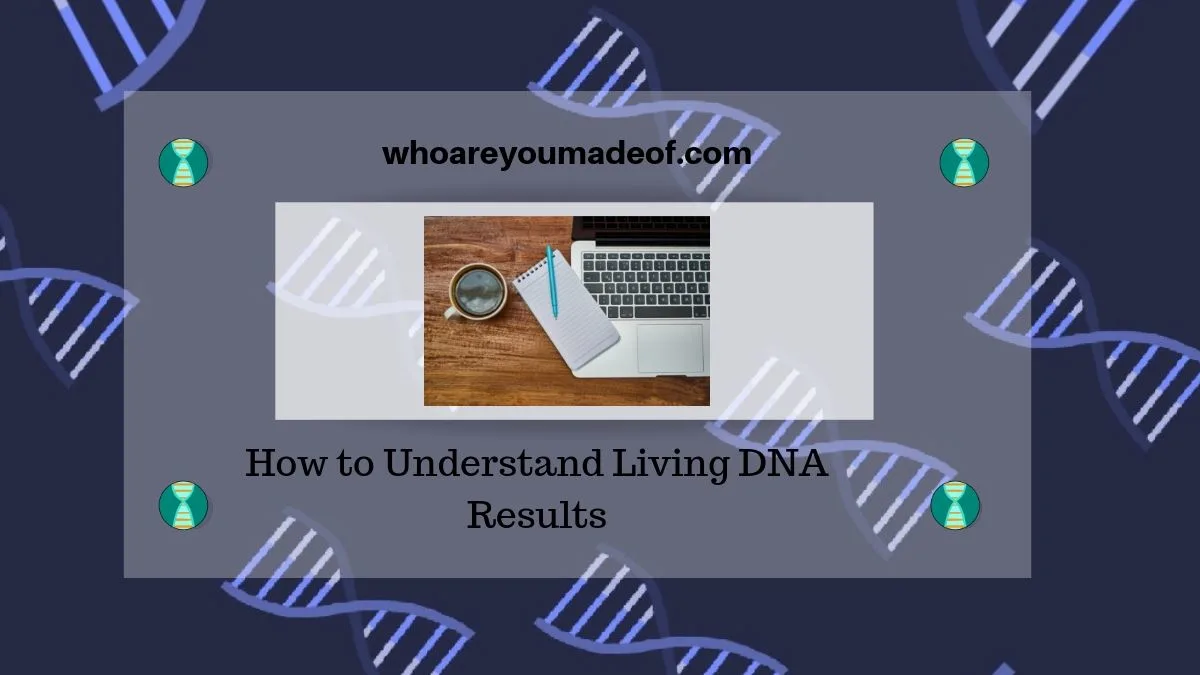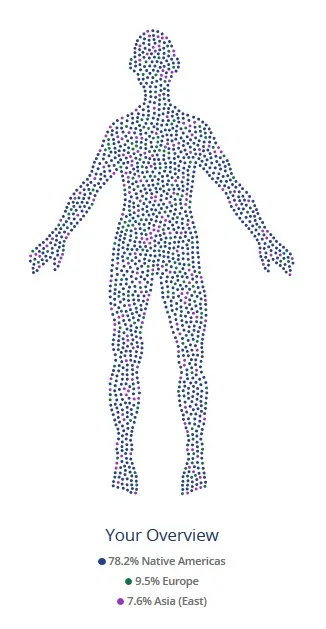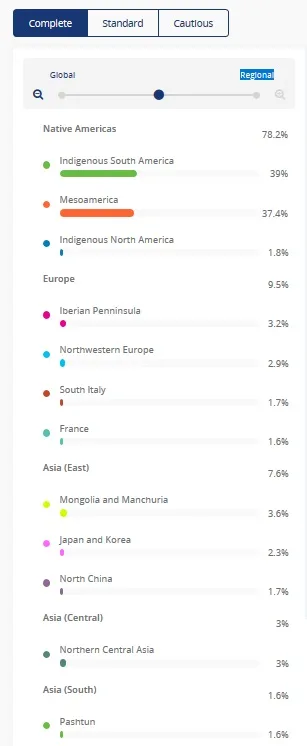Did you do a DNA test with Living DNA? Do you want to understand all aspects of your Living DNA Results? In this post, I'll explain Living DNA Results to help you get the most from your DNA testing experience.
You'll learn:
- How to understand your Family Ancestry results from Living DNA (your "ethnicity estimate")
- What you can learn from Family Networks
- The meaning of motherline and fatherline, and whether this information can help you with genealogy
- Additional ways that you can use your Living DNA Results

My husband generously volunteered to take a Living DNA test so I could write about his results. I really appreciate him sharing his results with us.
How to understand Family Ancestry results on Living DNA
The Living DNA Family Ancestry results show the regions of the world where your ancestors may have lived going back about 10 generations.
DNA testing companies are able to estimate where your ancestors lived by using advanced algorithms to compare your DNA to reference panels based on DNA samples from people living all over the world.
We inherit 50% of each of our parent's DNA, which is the inheritance pattern that occurs each generation. Because we don't inherit 100% of our mother and father's DNA, we don't share DNA with every single ancestor that we would find in our family tree.
Family Ancestry estimate is a very good snapshot into the course that our family has taken through history, based on DNA that did get passed down to us from our ancestors.
Your Family Ancestry information can be easily accessed via the "Explore in Full" button on your Living DNA results dashboard, as indicated in the image below:

To get started exploring my husband's results in full, we arrive at at a human body made from dots. Under the body, there are a few percentages representing his major ancestry regions:

The image above is just a general overview of my husband's ancestry, and it matches up very well with the other DNA tests that he has taken. When I first saw his results, I thought that this might be all that was included in his results.
As it turns out, there is much more that we can access. If we scroll down a bit more, we'll see a map of the world. To the left of the map, we can view a longer list of his ancestry regions, which include some regions that he only shares small percentages with.

On this more-detailed list, we can see two additional regions. This is just the beginning of what we can explore, however. Click the "Explore in full" button at the top of the map in order to see even more detail about the ancestry regions.
Exploring the Family ancestry results in full takes us to a map of the world where we see the regions that most closely match our DNA highlighted in a color coded map. The default view is the "Complete" "Global" view, displaying general regions that match our ancestry.
The "Complete" view attempts to define each portion of our DNA, even those small sections that don't perfectly match a particular region . Instead of reporting these small portions as unassigned or undetermined, Living DNA uses its technology to figure out which region is most similar to these small sections of DNA.

We can explore the "Complete" view in more detail by switching from the "Global" view to the "Regional" view. You will notice that the regions are more detailed and provide a more specific insight into where my husband's ancestors may have lived.
It's important to note that since this is the "Complete" view, some of the smaller percentages may not exactly match my husband's roots. In the image below, I cropped the map to save space and allow for better viewing of the specific regions:

To explore your results further, try switching between the "Complete" view to the "Standard" and "Cautious" views. You will see some regions disappear or become less defined.
Don't forget to toggle between the "Global" and "Regional" views on each tab!
The regions that never disappear completely are those that have a high confidence level, and you can be sure that your ancestors lived in those areas.
What are Family Networks on Living DNA?
Your Family Networks are your DNA matches, my absolute, number one favorite thing about DNA results.
Your Family Network DNA matches are people who are share DNA with you and are related to you genealogically in some way. While Living DNA provides us with details about the amount of shared DNA in percentage and centimorgan (cm) form, we will usually need to do a little detective work of our own to determine our exact relationship.
My husband doesn't have any DNA matches on Living DNA. This was a disappointment to him, of course, but we understand that the Living DNA database is still growing and he will eventually see his DNA match list grow.
Since my husband doesn't have any DNA matches for me to show you as an example, I can show you a DNA match from my own Family Networks list:

The person who you see on the top of my DNA match list is my mother, with whom I share 3,572 cMs of DNA on our Living DNA results. Since we share so much DNA, Living DNA is able to predict that we are either parent/child or full siblings.
There is always a range of shared DNA for any given relationship, and these ranges always overlap with the ranges seen for other relationships. This is why Living DNA reports a "predicted relationship" and cannot provide us with a definitive relationship based only on shared DNA.
One thing we can be sure of, however, is that we are definitely related in some way to the people on our Family Networks list.
What is the motherline on Living DNA?
From your Living DNA results dashboard, you will find your "motherline" results below your Family Ancestry results. The Family Ancestry, as well as the motherline and fatherline results, are located under the "Ancestry" tab.
The Living DNA mitochondrial (mtDNA) DNA results, also called "motherline" results, can help you learn about the path that your direct female ancestors took over the course of thousands of years.
Mitochondrial DNA is passed down from a mother to her male and female children, so both men and women have mitochondrial DNA. mtDNA is not passed down from males to their children, however, so mtDNA results represent a very small portion of your direct ancestors.
This means that mtDNA results are from your direct female line. In other words, your mother's mother's mother's mother's mother (etc), going back thousands of years.
Mitochondrial DNA results are typically reported as haplogroups, which are groups of people who share common direct-line maternal or paternal ancestors. People who share the same mtDNA haplogroup as you are related to you via an almost always unknown, distant maternal-line ancestor.
What is the fatherline on Living DNA?
Your fatherline results on Living DNA, similar to motherline results, can help you understand more about your direct-line paternal ancestors. Your direct-line paternal ancestors go in a straight line from your father to your father's father, and your father's father's father, and so on.
The Living DNA fatherline tests for Y-DNA. Like all Y-DNA tests, no matter which company you do a DNA test with, you can only get Y-DNA results if you inherited Y-DNA from your father.
Unfortunately for us ladies, only men inherit Y-DNA. This means that if we have brothers, they inherited Y-DNA from our fathers while we didn't.
If you are female, you will not have information in your fatherline section of Living DNA results. Males will have a haplogroup similar to, but also different from, the motherline haplogroups.
Your motherline and fatherline haplogroup information cannot directly help you build a family tree, but it can be informative. There are many research projects dedicated to mtDNA and Y-DNA studies, and these studies can help you trace the origins of your motherline and fatherline, as well as help direct your own genealogical efforts.
What else can I do with my Living DNA results?
Living DNA allows you to download your DNA data in a special file format that can be uploaded to other DNA-related sites.
For example, you can upload your Living DNA file to Gedmatch and My Heritage in order to get more DNA matches and access to DNA analysis tools.
Coming soon, I will include a detailed post explaining how to download your raw DNA data file from Living DNA. For now, you can navigate the process on your own through the "Download Raw Data" tab on the left side of the screen from your results dashboard.
How to get a Living DNA test?
If you haven't yet done your Living DNA test, or you would like to get a Living DNA test to help build up their database of DNA matches, you can use the link below to get your kit.
Conclusion
I hope that this post has helped you understand more about your Living DNA results, including your family ancestry, motherline, and fatherline. Living DNA results are a great way to learn about your ancestry, and I hope that you are interested in learning as much as you can from your DNA testing experience.
If you have any questions about something that you read in this post, or if you would like to share your own experience with Living DNA results, I would love to hear from you in the discussion below.
Thanks for stopping by today!


Jim Creech
Sunday 29th of October 2023
I did a Living DNA test about a year and a half ago. I was quite pleased. The "Recent Ancestry" results were very interesting. There were broken down into several regions within a country. Since all my DNA was from the UK and Ireland this was very informative. Living DNA is a British company, so they are great at British DNA, but I understand they are good universally. One interesting result was there was no evidence of Fife County, Scotland linage. The family claims to be Scots Irish and from Fife County originally. The Creech name is far more common in the south of England, which did show up in my DNA regions. Ireland was also in my DNA results. So are we Brits - Irish or has the Creech line fallen out of my DNA over the generations. Questions to solve. But as you know 17th and 18th century records are tough to find. But at least I am aware of possible mistakes in my family history. By the way I was able to match up with a lady (rather her niece as she is dead) through matching. Her DNA and tree matched at our gggg grandfather. Thanks for all your great articles!
Rob
Saturday 29th of July 2023
You CANNOT upload LivingDNA results to MyHeritage, that site will reject the file. Even if it has been converted to another format it will still be rejected.
Rick Childers
Tuesday 21st of February 2023
I had my DNA tested by Living DNA. Is it safe to share it on Gedmatch? My DNA Haplogroup is I1 and that it is a very ancient DNA. Says that it is the original DNA of the Nordic People of Europe. Can that be true?